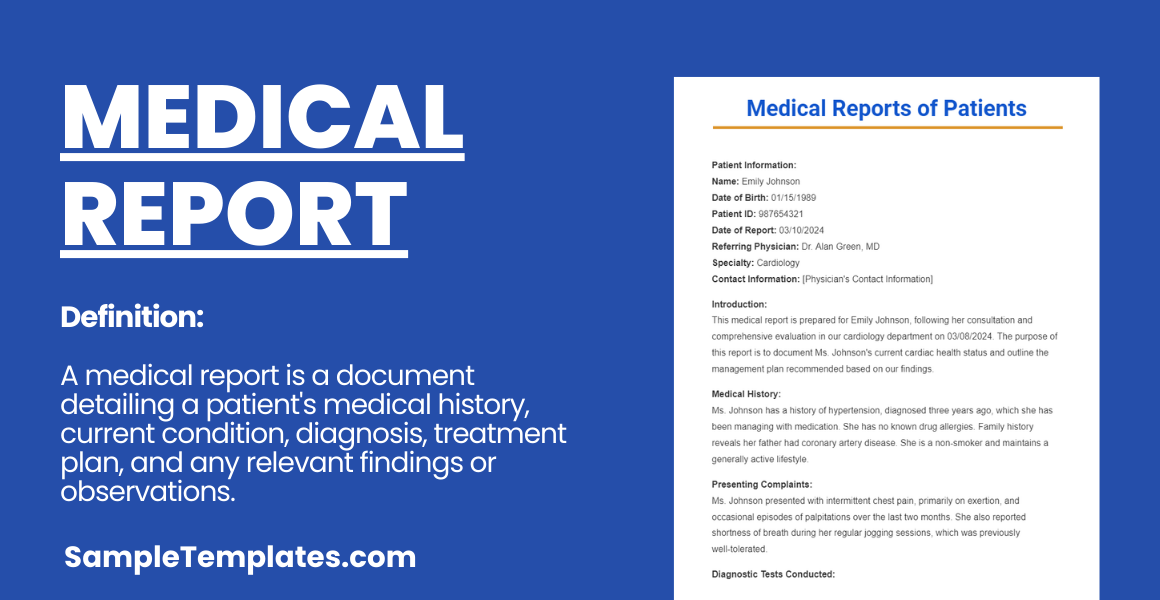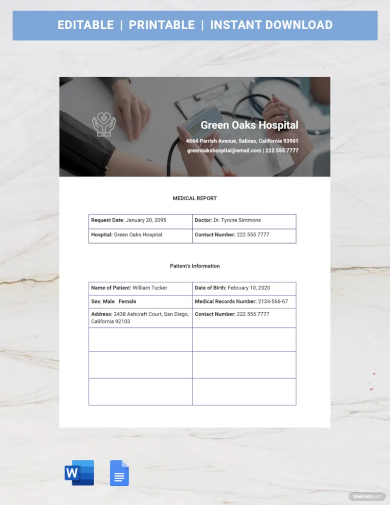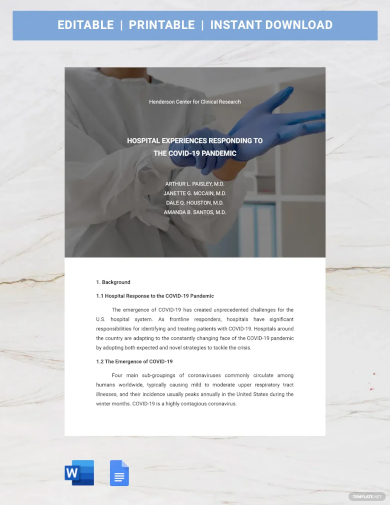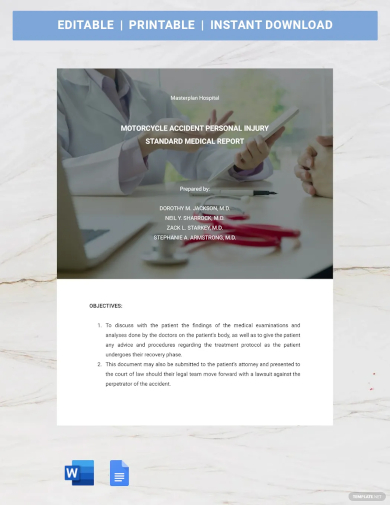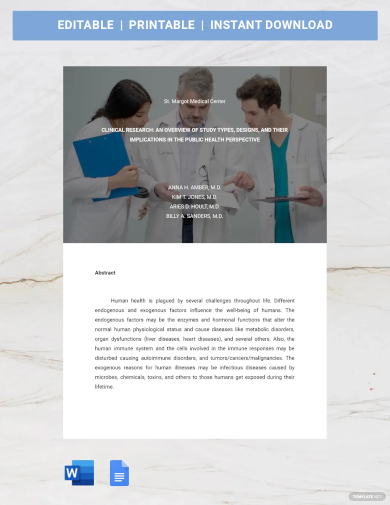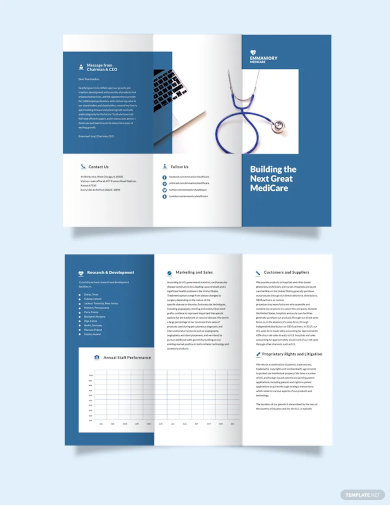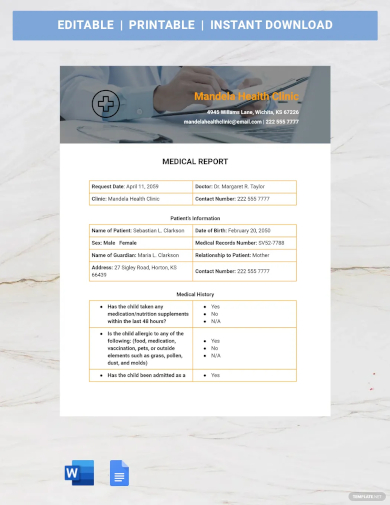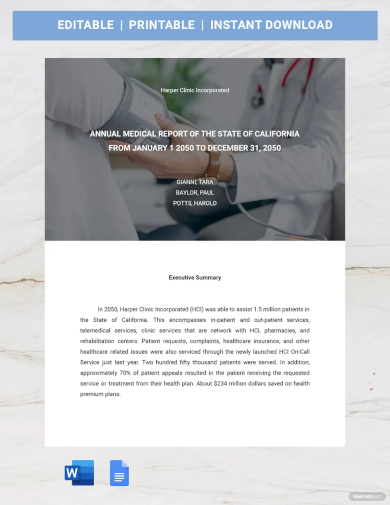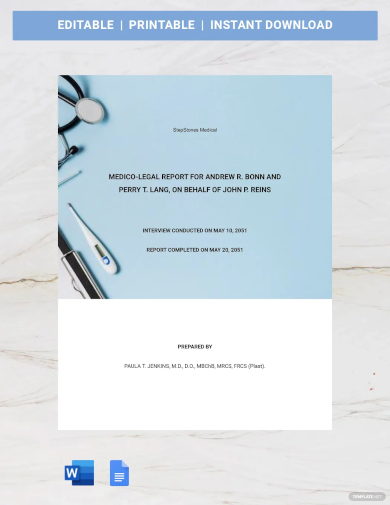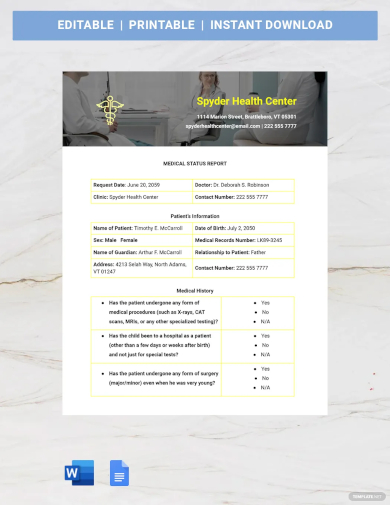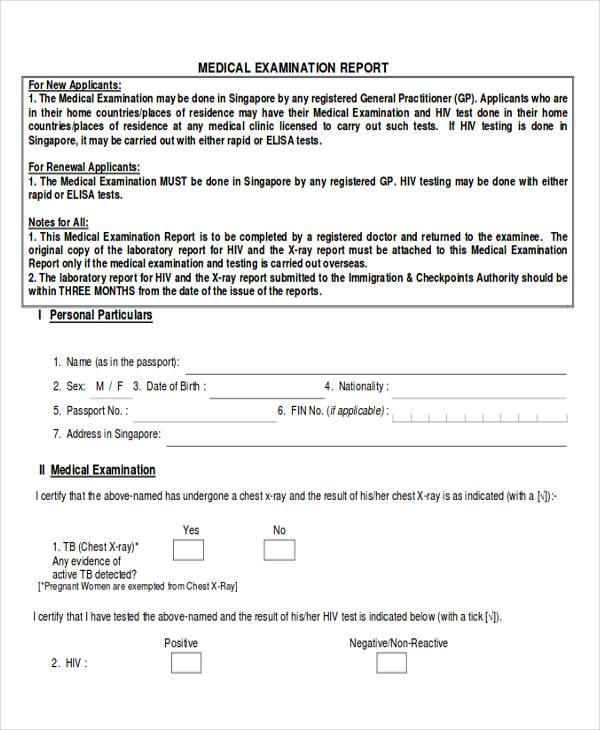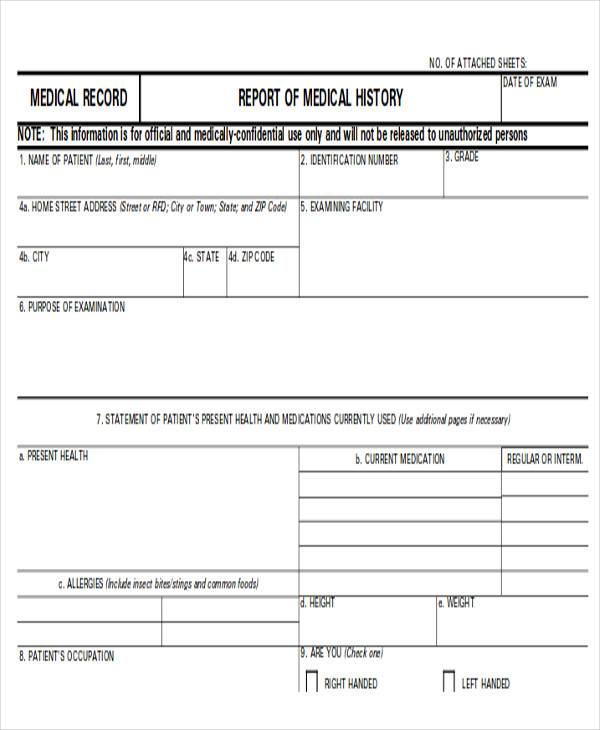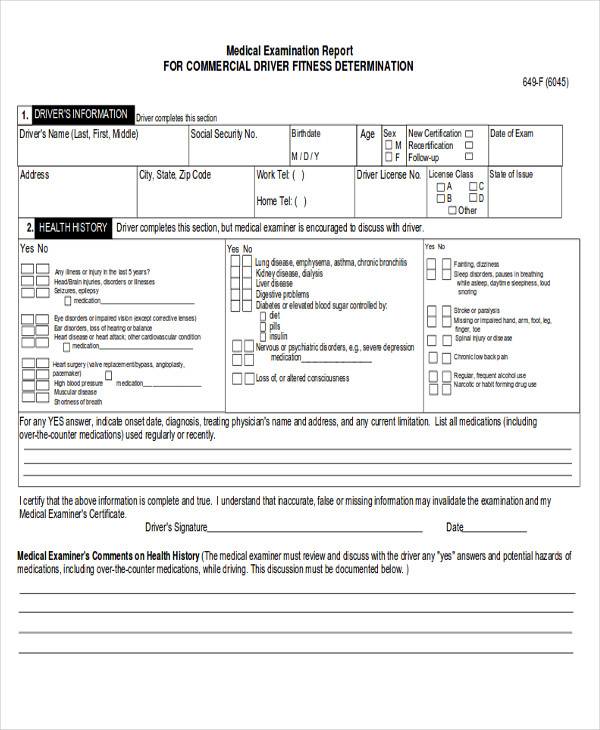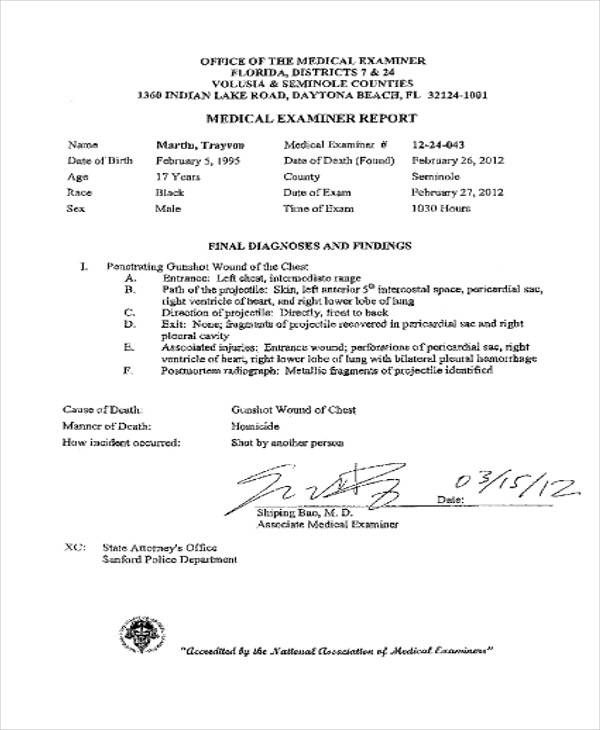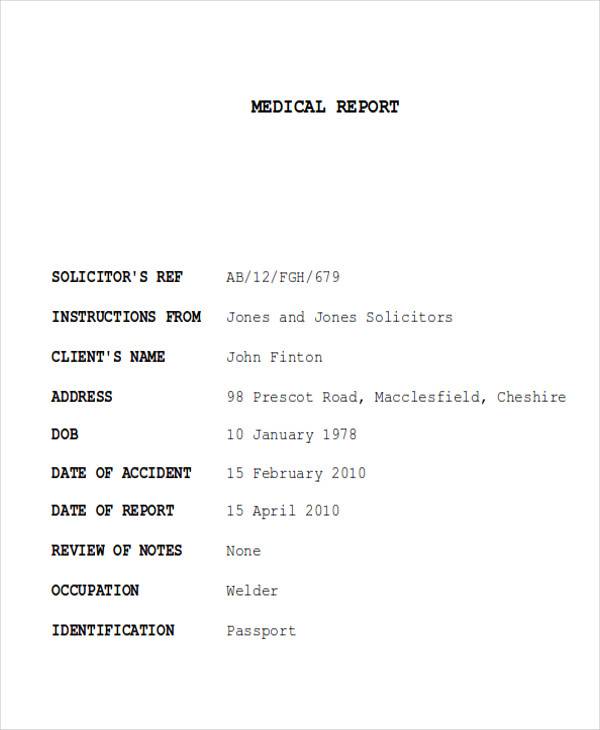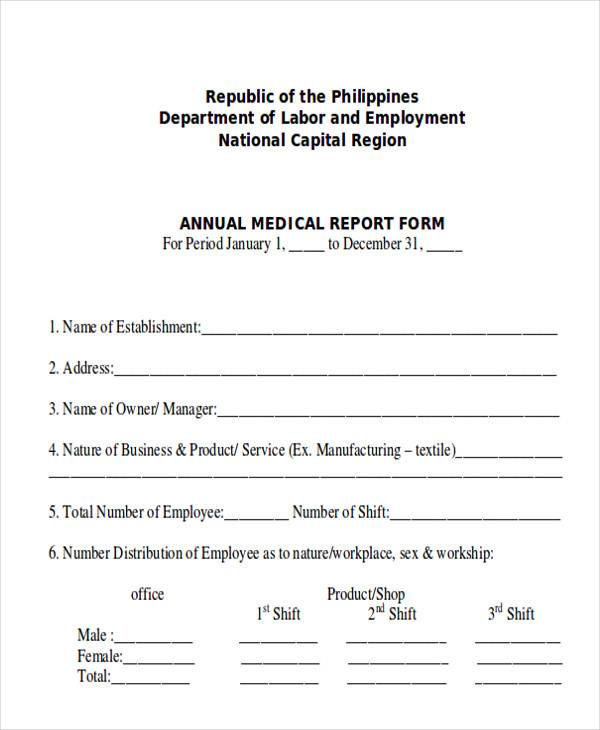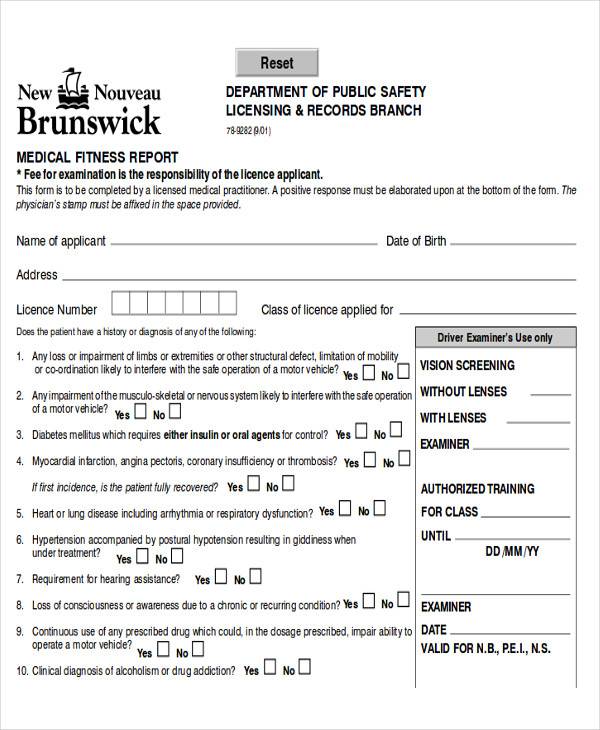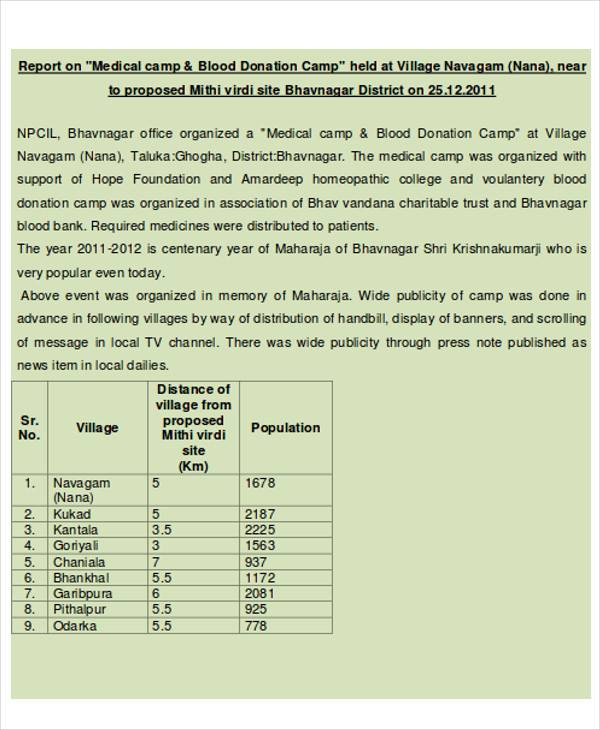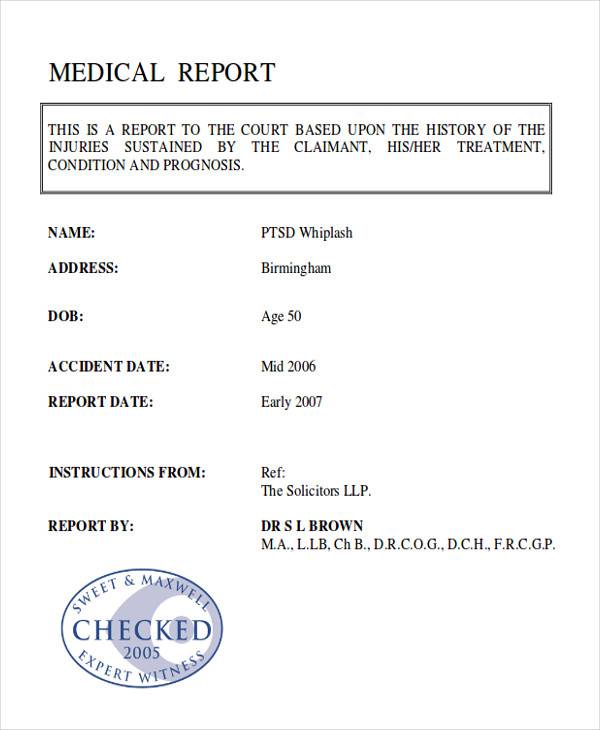Doctors are oftentimes requested by their patients to give them a copy of the report that they have about them. This helps to give the patient security and ease of mind since they know what their current status is with regard to their health. You may also see medical records request forms.
If you are a doctor who is currently looking for ways of presenting your medical reports, you have just landed on the correct website. There are a couple of sample reports in this article that can help you make a report that will be easily understood by the patients. Keep scrolling to check out all of the medical report samples available for your perusal.
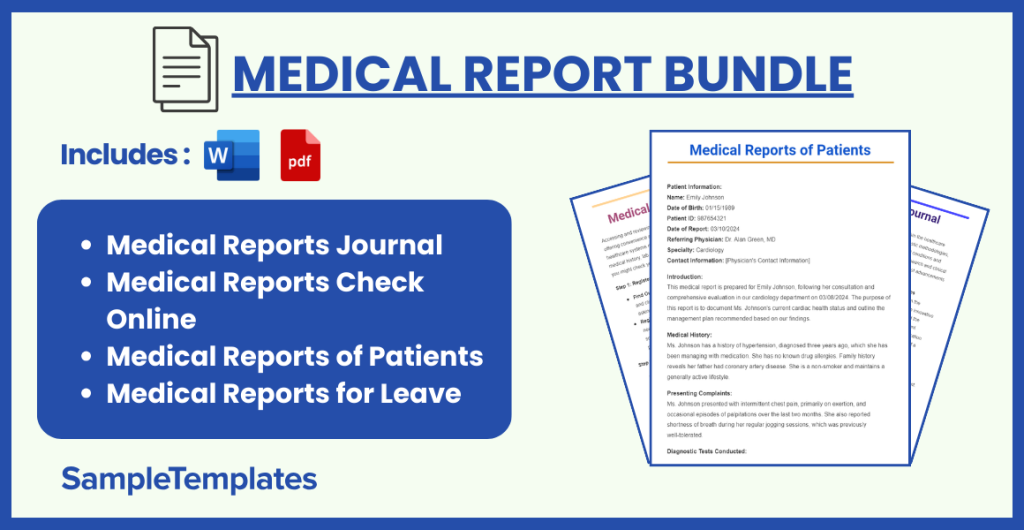
Download Medical Reports Bundle
Medical Reports Journal
The Medical Reports Journal serves as a pivotal publication within the healthcare sector, offering an extensive array of patient case studies, diagnostic methodologies, treatment outcomes, and scholarly discussions on various medical conditions and treatments. This journal aims to bridge the gap between medical research and clinical practice, providing healthcare professionals with insights into the latest advancements and challenges in medicine.
Featured Case Study: Managing Complex Cardiovascular Conditions
In a recent edition, the journal highlighted a groundbreaking case study on the management of complex cardiovascular conditions, specifically focusing on innovative treatment approaches for coronary artery disease (CAD). The study detailed the diagnostic process involving advanced imaging techniques and the subsequent multidisciplinary treatment plan that included minimally invasive surgery, medication adjustments, and lifestyle intervention. This case underscored the importance of a tailored approach to patient care in improving outcomes.
Diagnostic Innovations Section
A dedicated section on diagnostic innovations showcased the development and application of cutting-edge diagnostic tools in early disease detection and management. One notable feature discussed the implementation of AI-driven diagnostic platforms in identifying subtle radiographic changes indicative of early-stage cancers, significantly improving the accuracy and speed of diagnosis.
Treatment Outcomes and Research
The journal regularly publishes articles on treatment outcomes and ongoing research, providing valuable data on the efficacy of new and existing treatments across various medical disciplines. A recent publication examined the long-term outcomes of immunotherapy in treating certain types of cancer, offering insights into patient survival rates, quality of life, and potential side effects.
Ethical Considerations in Medical Practice
Recognizing the importance of ethics in medical practice, the Medical Reports Journal includes discussions on ethical dilemmas faced by healthcare professionals. Topics such as patient confidentiality, informed consent, and the ethical implications of genetic testing are explored through case studies and expert commentary, fostering a culture of ethical awareness and sensitivity in medical practice.
Global Health Challenges
In response to the evolving global health landscape, the journal features articles on emerging health challenges, such as the management of infectious diseases, antibiotic resistance, and the impact of climate change on public health. These articles aim to inform and prepare healthcare professionals for addressing these global challenges through evidence-based practices and international collaboration.
Conclusion
The Medical Reports Journal remains at the forefront of medical publication, continually providing healthcare professionals, researchers, and educators with comprehensive and insightful content. Through its diverse range of articles, the journal contributes to the advancement of medical knowledge, the improvement of patient care, and the promotion of public health worldwide.

Medical Reports Check Online
Accessing and reviewing medical reports online has become increasingly common, offering convenience and efficiency for both patients and healthcare providers. Many healthcare systems now utilize secure, online portals where patients can view their medical history, lab results, and diagnostic reports. Here’s a general overview of how you might check your medical reports online:
Step 1: Register for the Patient Portal
- Find Out if Your Healthcare Provider Offers an Online Portal: Most hospitals and clinics now provide an online patient portal. You can find out if yours does by asking your healthcare provider or checking their website.
- Register for an Account: To access your medical reports online, you’ll typically need to register for an account on the patient portal. This often involves providing some personal information, like your date of birth, and creating a username and password.
Step 2: Log In to the Portal
- Once you have your login credentials, access the patient portal through the healthcare provider’s website or by using a provided link. Enter your username and password to log in.
Step 3: Navigate to Your Medical Reports
- After logging in, look for a section labeled something like “Lab Results,” “Medical Records,” “Documents,” or “Reports.” The exact terminology may vary depending on the portal.
- Click on the relevant section to view your medical reports. You may find different categories for lab results, imaging reports, visit summaries, and other documents.
Step 4: Review Your Reports
- You can usually click on each report to open and review it. Some portals also allow you to download or print the reports for your records or to share with other healthcare providers.
Step 5: Understand Your Reports
- Medical reports can contain complex terminology and data. If you have questions about what you read, make a note of them. You can discuss these questions with your healthcare provider during your next appointment for clarification.
Privacy and Security
- Patient portals are designed with privacy and security measures to protect your health information. Ensure you keep your login information confidential and log out after each session, especially if using a shared or public computer.
Technical Support
- If you encounter any difficulties accessing or navigating the patient portal, look for a “Help” or “Support” section on the portal for assistance. Many healthcare providers also offer technical support via phone or email.
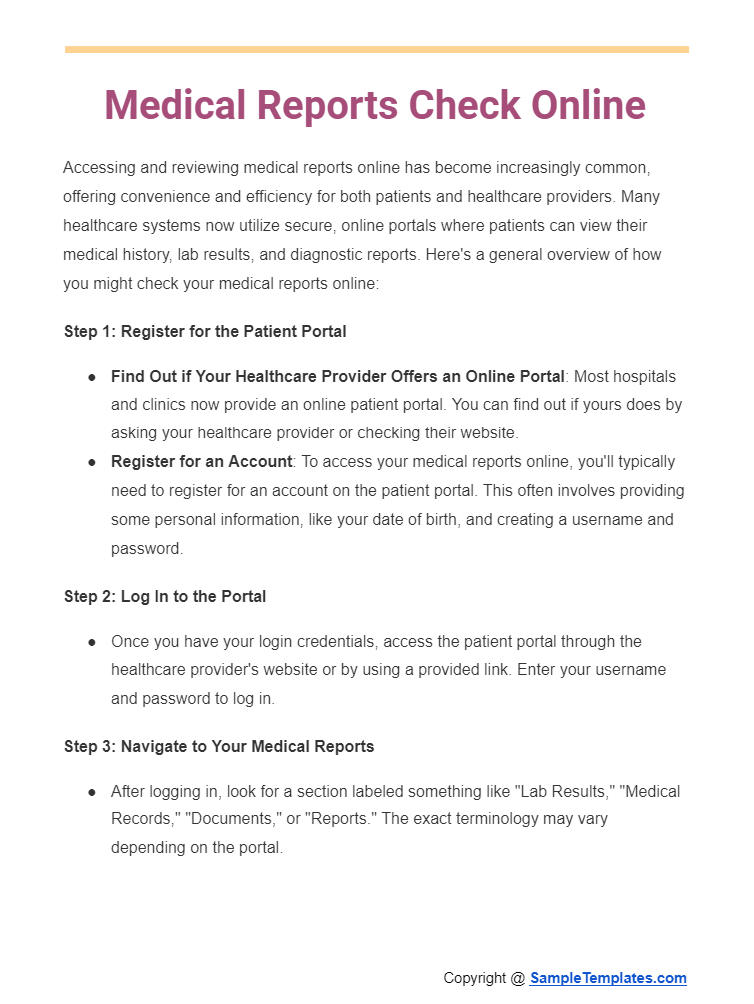
Medical Reports of Patients
Patient Information:
Name: Emily Johnson
Date of Birth: 01/15/1989
Patient ID: 987654321
Date of Report: 03/10/2024
Referring Physician: Dr. Alan Green, MD
Specialty: Cardiology
Contact Information: [Physician’s Contact Information]
Introduction:
This medical report is prepared for Emily Johnson, following her consultation and comprehensive evaluation in our cardiology department on 03/08/2024. The purpose of this report is to document Ms. Johnson’s current cardiac health status and outline the management plan recommended based on our findings.
Medical History:
Ms. Johnson has a history of hypertension, diagnosed three years ago, which she has been managing with medication. She has no known drug allergies. Family history reveals her father had coronary artery disease. She is a non-smoker and maintains a generally active lifestyle.
Presenting Complaints:
Ms. Johnson presented with intermittent chest pain, primarily on exertion, and occasional episodes of palpitations over the last two months. She also reported shortness of breath during her regular jogging sessions, which was previously well-tolerated.
Diagnostic Tests Conducted:
- Electrocardiogram (ECG): Showed slight ST-segment depressions in leads II, III, and aVF.
- Echocardiogram: Revealed a normal left ventricular ejection fraction with no significant valvular abnormalities.
- Treadmill Stress Test: Demonstrated decreased exercise tolerance with reproducible chest discomfort and corresponding ECG changes.
- Coronary Angiography: Indicated moderate stenosis in the proximal left anterior descending (LAD) artery.
Diagnosis:
The findings suggest a diagnosis of stable angina pectoris, likely secondary to coronary artery disease affecting the LAD artery.
Treatment Plan:
- Medication Adjustment: Introduction of a beta-blocker to manage angina symptoms and continue antihypertensive medication.
- Lifestyle Modifications: Advise on a low-cholesterol diet, continued physical activity within comfort limits, and stress management techniques.
- Follow-Up: Scheduled for a review in 6 weeks to evaluate symptom control and medication tolerance. Further evaluation with repeat stress testing planned in 3 months.
- Cardiac Rehabilitation: Recommended enrollment in a cardiac rehabilitation program to facilitate safe exercise training and education on heart-healthy living.
Recommendations:
Given Ms. Johnson’s diagnosis and current symptoms, it is crucial to closely monitor her cardiac status and adjust the treatment plan as necessary. Adherence to medications, lifestyle changes, and regular follow-up appointments are essential components of managing her condition and preventing potential complications.
Conclusion:
Ms. Johnson’s case of stable angina requires careful management to improve her quality of life and prevent the progression of coronary artery disease. The outlined treatment and follow-up plan aim to achieve optimal control of her symptoms and address the underlying risk factors for coronary artery disease.
Physician’s Signature:
Dr. Alan Green, MD
[Date]
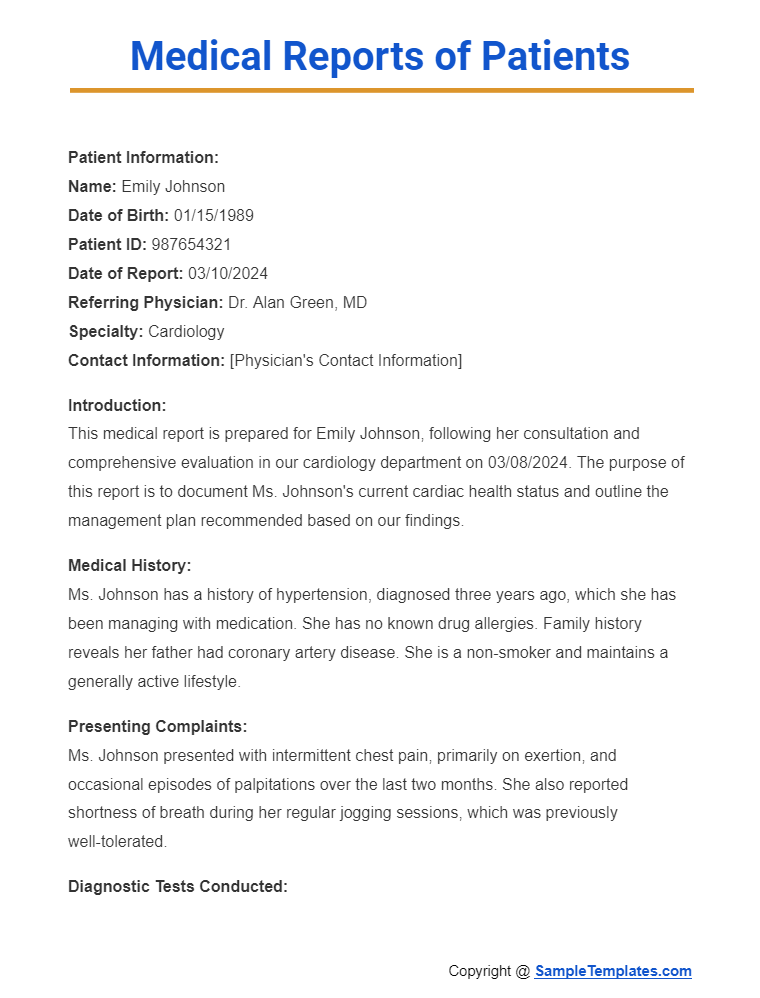
Medical Reports for Leave
Patient Name: John Doe
Date of Birth: MM/DD/YYYY
Date of Examination: MM/DD/YYYY
Physician: Dr. Jane Smith, MD
Specialty: General Medicine
Contact Information: [Physician’s Contact Information]
Introduction:
This medical report is prepared for John Doe following a comprehensive medical examination and evaluation on [Date of Examination]. The purpose of this report is to document Mr. Doe’s current health status and provide a professional medical opinion regarding his ability to perform work duties.
Medical History:
Mr. Doe has a history of asthma, which he has managed with medication and lifestyle adjustments. He has no known allergies. His last physical examination was conducted on [Last Physical Exam Date], with no significant health issues reported at that time.
Presenting Symptoms:
Mr. Doe presented with symptoms indicative of acute bronchitis, including persistent cough, wheezing, shortness of breath, and fatigue. These symptoms have been present for approximately [Number of Days] days prior to the examination.
Diagnostic Tests Conducted:
- Chest X-Ray: To rule out pneumonia, which showed no signs of lung infection.
- Pulmonary Function Test: Indicating decreased lung capacity, consistent with acute bronchitis in the context of underlying asthma.
- Blood Tests: Including a complete blood count (CBC), which showed elevated white blood cells, indicative of an ongoing inflammatory process.
Diagnosis:
Based on the clinical examination, history, and diagnostic tests, the diagnosis is acute bronchitis superimposed on chronic asthma.
Treatment Plan:
- Medication: Prescribed a course of antibiotics to address any bacterial infection, along with a corticosteroid inhaler to reduce inflammation and bronchodilators to improve breathing.
- Rest: Recommended significant rest to facilitate recovery.
- Follow-up: Scheduled a follow-up appointment in [Number of Weeks] weeks to reassess lung function and overall health status.
Medical Opinion for Work Leave:
Given Mr. Doe’s current respiratory condition and the physical demands of his job, it is medically advisable for him to refrain from work and focus on recovery. I recommend a medical leave of absence for a period of [Number of Weeks] weeks, during which time he should avoid exposure to irritants, continue with the prescribed treatment, and rest adequately.
Conclusion:
Mr. Doe’s health condition necessitates a temporary leave from work to allow for a full recovery. Returning to work prematurely may exacerbate his condition and delay the recovery process. I am available to provide further information or clarification as needed.
Physician’s Signature:
[Physician’s Signature]
[Date]
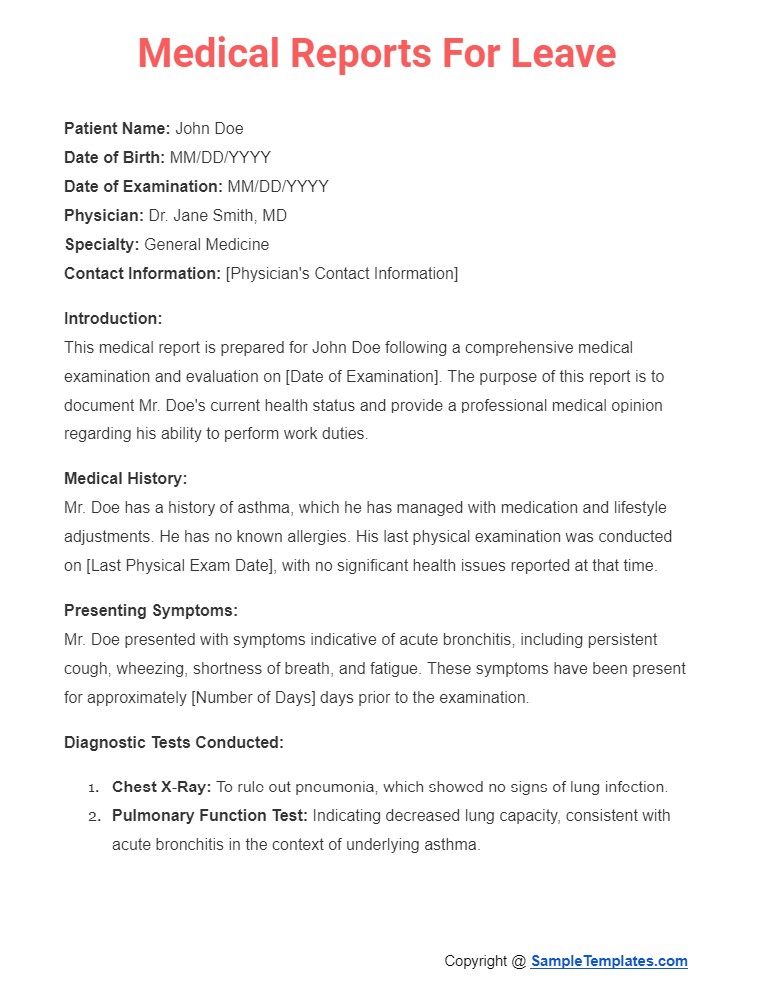
Browse More Templates On Medical Reports
Medical Report Template
Online Medical Report Template
Free Standard Medical Report Template
Hospital Medical Report Template
Medical Annual Report Tri-Fold Brochure Template
Medical Summary Report Template
Medical Narrative Report Template
Tips For Writing a Medical Report
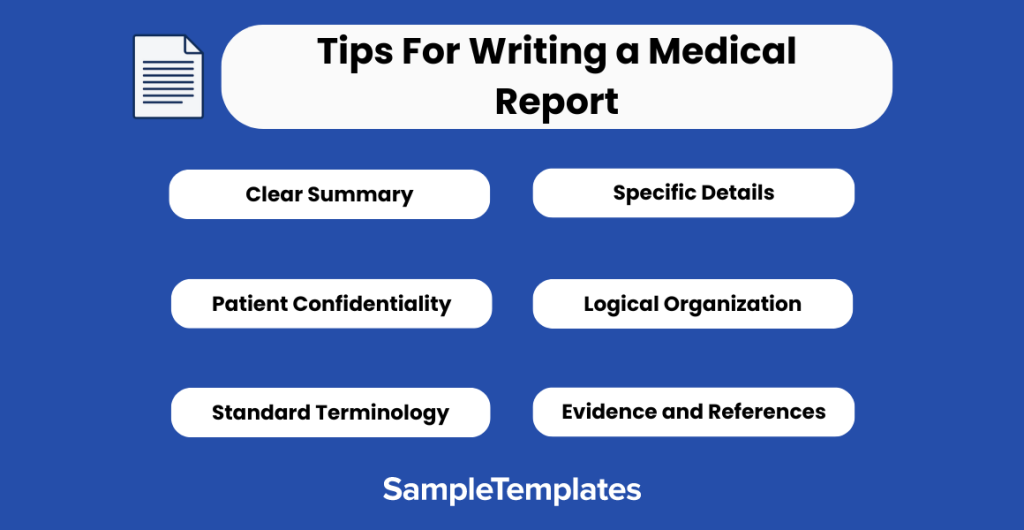
- Start with a Clear Summary: Begin your medical report with an executive summary that highlights the main findings, diagnosis, and recommendations. This allows readers to quickly understand the report’s key points.
- Maintain Patient Confidentiality: Always adhere to privacy laws and regulations, such as HIPAA in the United States, by anonymizing patient information or obtaining consent when necessary.
- Use Standard Medical Terminology: Ensure accuracy and clarity by using standardized medical terminology. Avoid colloquialisms that might confuse the reader or misrepresent the medical conditions.
- Be Specific and Detailed: Provide detailed descriptions of the patient’s history, symptoms, examinations conducted, diagnostics, treatments, and outcomes. Specificity helps in understanding the case’s complexity and the reasoning behind medical decisions.
- Organize Information Logically: Structure your report in a logical order, typically starting with patient information, medical history, clinical findings, diagnosis, treatment, and follow-up. Use headings and subheadings to guide the reader through the report.
- Incorporate Evidence and References: When discussing diagnosis or treatment options, refer to relevant medical research or guidelines to support your conclusions. Citing evidence adds credibility to your report.
- Include Visuals When Appropriate: Use charts, graphs, and images, such as X-rays or scan results, to provide visual context to your findings. Ensure visuals are clearly labeled and referenced in the report.
- Review and Revise: Before finalizing the report, review it for accuracy, coherence, and completeness. Consider having a colleague or a medical editor review it as well to catch any errors or omissions.
Following these tips can help ensure your medical report is informative, accurate, and valuable to its intended readers, whether they are healthcare professionals, patients, or regulatory bodies.
Medical Annual Report Template
Medical Legal Report Template
Medical Status Report Template
Medical Incident Report Template
Medical Annual Report Bi-Fold Brochure Template
Impact Factor of Journal of Medical Case Reports
As of my last update in April 2023, I can’t browse the internet or access real-time data, which includes the current impact factor of specific journals like the Journal of Medical Case Reports. The impact factor of a journal can vary from year to year. It’s calculated based on the yearly average number of citations that recent articles published in a journal received. To find the most current impact factor for the Journal of Medical Case Reports, you should refer to the Journal Citation Reports (JCR) database by Clarivate or the journal’s website. Additionally, academic libraries and institutions often provide access to these resources.
Medical Examination Report Template
Medical History Report Format
Medical Examination Report Template
Medical Report Format
Medical reports are basically a written report of the results of a patient’s checkup or medical exam. These documents are usually requested by patients and are used for different kinds of situations. They are usually composed of fields that collect the following information:
1. Patient Details
- Name
- Address list
- Date of birth
- Marital status
- Personal medical history, which will include immunizations, hospitalization, allergies, previous illnesses, and injuries
- Family medical history such as diabetes, cancer, hypertension, and the like
2. Medical Examiner Report
- Overall health status
- Overall physical exam
- X-ray report
- Name and signature of medical examiner
Basing Medical Reports on Medical Records
Medical reports are usually based on the patient’s own report and the doctor or medical examiner’s observations. These are systematic and organized records about the patient’s health. These ensure that continuous care for patients are assured as it has all the necessary information about the patient.You may also see service reports
Medical reports are usually used by patients for a wide variety of situations, which include employment purposes, government applications, and other regulatory bodies. You may also see case reports.
Other reports you might be interested in are:
Medical Examiner Report Template
Sample Medical Report Template
Annual Medical Report Form Template
Printable Medical Fitness Report Template
Medical Camp Report in PDF
Medical Legal Report Template
Writing a Good Medical Report
1. A medical report is considered to be a good one if it is complete with the fields that are needed to collect data necessary to declare if a person is fit or otherwise. You may also see medical records release forms
2. It should also list down a log of all the medications if there are any and a log of the patient’s past and present medical conditions. You may also see nursing reports.
The samples that we have prepared for you to choose from are high in quality and are sure to give you a good reference for making your very own medical report. A few good reasons why you should choose our templates are the following:
1. They are offered for free. This means that you do not need to pay a single dime once you decide to click on the download button. You may also see incident report formats.
2. They are high in quality despite being offered for free.
3. They have all the details needed in a medical report. You may also see clinical audit report
4. They are compatible with a lot of devices available in the market.
5. They are downloadable in PDF form, which means that the format and design will not budge once you preview it.
There you have it! We hope our article helped you out. You may also be interested in checking out our book reports.
How to Write a Good Medical Report?
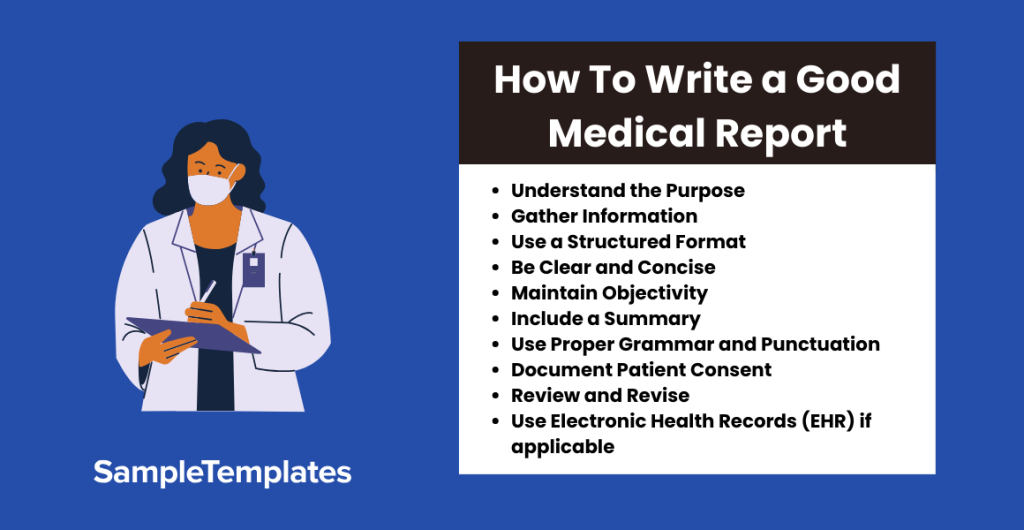
Writing a good medical report is essential for effective patient care, communication with colleagues, and documentation. Here are some key steps to help you write a comprehensive and clear medical report:
1.Understand the Purpose:
Before you begin, determine the purpose of the report. Is it for patient history, diagnosis, treatment, follow-up, or legal documentation? Understanding the purpose will guide your writing.
2. Gather Information:
Collect all relevant patient information, including medical history, current symptoms, physical exam findings, test results, and any other pertinent data.
3. Use a Structured Format:
Medical reports typically follow a structured format, which may vary depending on the type of report (e.g., progress note, discharge summary, consultation report). Common sections include:
- Patient demographics: Include the patient’s name, age, gender, and medical record number.
- Chief complaint: Clearly state the reason for the patient’s visit.
- History of present illness (HPI): Describe the current symptoms in detail, including their onset, duration, severity, and any exacerbating or relieving factors.
- Past medical history: Summarize the patient’s medical conditions, surgeries, allergies, and medications.
- Family and social history: Include relevant family medical history and the patient’s lifestyle factors.
- Review of systems: Briefly list and describe any other symptoms or concerns the patient may have.
- Physical examination findings: Document your findings from the physical examination, including vital signs.
- Diagnostic tests and results: Include any laboratory, imaging, or other test results.
- Assessment and diagnosis: Provide your assessment of the patient’s condition and any confirmed diagnoses.
- Plan: Outline the treatment plan, including medications, procedures, follow-up recommendations, and patient education.
Follow-up instructions: Clearly communicate to the patient what they need to do next.
4. Be Clear and Concise:
Use clear and concise language. Avoid jargon and complex medical terminology when communicating with patients, and use terminology that is appropriate for the intended audience.
5. Maintain Objectivity:
Present facts objectively and without bias. Avoid making judgments or speculations that are not supported by evidence.
6. Include a Summary:
Provide a summary of the key findings and recommendations at the beginning or end of the report. This helps readers quickly understand the main points.
7. Use Proper Grammar and Punctuation:
Ensure your report is free of grammatical errors and typos. Maintain a professional tone throughout.
8. Document Patient Consent:
Ensure you have the necessary patient consent and follow all relevant legal and ethical guidelines when documenting sensitive information.
9. Review and Revise:
Carefully review your report to ensure accuracy and completeness. Verify that all sections are organized logically and that the information flows smoothly.
10. Use Electronic Health Records (EHR) if applicable:
If your healthcare institution uses electronic health records, make sure you are familiar with the EHR system and use it to document patient information accurately.
FAQS
What is in a medical report?
A medical report typically includes patient demographics, chief complaint, history of present illness, past medical history, family and social history, review of systems, physical examination findings, diagnostic test results, assessment, plan, and follow-up instructions
What are the four basic medical reports?
The four basic medical reports are: progress notes, discharge summaries, consultation reports, and history and physical examination reports. Each serves a distinct purpose in documenting patient care and facilitating communication among healthcare providers.
How long does it take for a medical report?
The time required to complete a medical report varies depending on factors such as the complexity of the case, the amount of information to be included, and the urgency of the report.
What are the two most common types of medical records?
The two most common types of medical records are Electronic Health Records (EHRs) and Paper-based Medical Records. EHRs are digital records stored electronically, while paper-based records are physical documents containing patient information.
What is a medical progress report?
A medical progress report is a document that summarizes a patient’s current health status, including their symptoms, diagnosis, treatment plan, and any changes or improvements observed over a specific period of time.
In conclusion, medical reports play a crucial role in patient care by documenting comprehensive information about a patient’s health status, treatment plan, and progress over time. Clear and accurate reporting supports effective communication, informed decision-making, and continuity of care.
Related Posts
Sample Science Project Reports
Business Report Samples & Templates
Survey Reports Samples & Templates
Sample Feasibility Reports
Psychological Assessment Report Samples [ Clinical, Child, Intake ]
Report Format Samples & Templates
Acknowledgement for Internship Report Samples [ Hotel, Hospital, Teaching ]
Field Trip Report Samples [ Agriculture, Educational, Environmental ]
Student Counseling Report Samples
Narrative Accomplishment Report Samples [ Science, Teacher, Reading ]
Sample Acknowledgment Report Templates
Internship Narrative Report Samples
Interview Summary Report Samples
Accomplishment Report Samples
Acknowledgement for Project Report Samples [ MBA, Engineering, Internship ]
